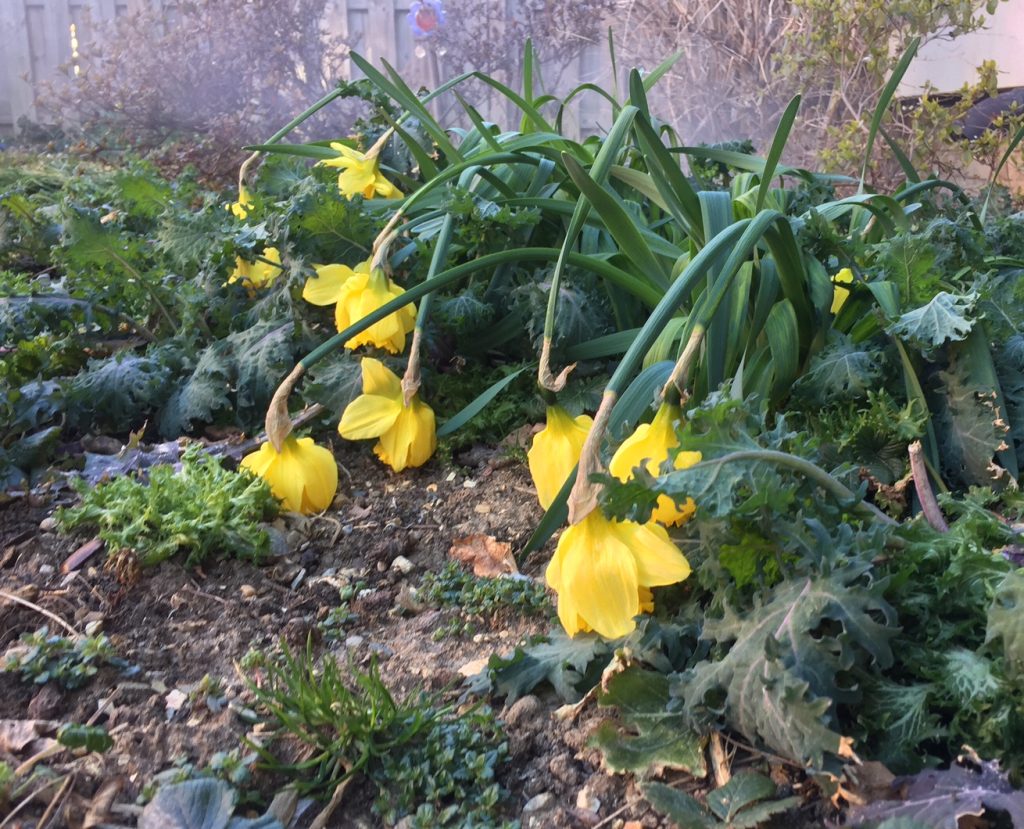Marlisa Yoder-Bontrager lives with her husband in a four-unit apartment building in the city of Lancaster, Pa., where she enjoys the challenge of making a small city yard both beautiful an d food producing. An array of solar panels on the building’s roof gives enough energy to power their home plus channeling about two thirds more back to the electric grid. She has provided leadership for East Chestnut Mennonite Church’s Creation Care Committee and serves on Mennonite Creation Care Network’s Creation Care Council.
d food producing. An array of solar panels on the building’s roof gives enough energy to power their home plus channeling about two thirds more back to the electric grid. She has provided leadership for East Chestnut Mennonite Church’s Creation Care Committee and serves on Mennonite Creation Care Network’s Creation Care Council.
Reading Michael Pollan’s In Defense of Food and Eliot Coleman’s Four Season Harvest several years ago dovetailed with our purchase of a row house with a narrow back yard in the middle of our city. My husband and I were determined to not add mowing the lawn of this property to our already long list of chores. Instead we converted the lawn to garden and added the ginormous job of growing as much of our own food as possible on this bit of urban land.
To do this we’ve changed out and upgraded the way we grew up gardening when space was ample and our families seemed to think that hoeing weeds under a scorching summer sun was essential to building a decent human person. Now we scrunch plants just close enough to each other so they’ll still grow, but without wasting precious space between them. We interplant so that endive and lettuce are lounging in the shade of the tomato plants in August and September, waiting for their move into the hoop house that we put up over the garden space come cold weather. As soon as one crop is harvested, the dust hardly settles before we plant new seeds in its place. The fire escape gets enough sun to allow vine beans to cling to it throughout the summer and the 6-foot fence around the property’s edge is a good neighbor that also holds our butternut squash and cucumbers. To support all this growth, we compost, and when we happen by a cow or horse farmer are rarely shy in asking if we can please haul away some buckets of their good, stinky stuff.
Daffodils Flopped But Carrots Persisted
Last Thursday, at the beginning of March, after several weeks of weather warm enough to belong to May, I decided to ignore the usual advice about planting potatoes and onions on St. Patrick’s Day and go for it – two weeks early. I scraped off the leaf mulch we had put on in the fall and was rewarded w ith the sight of a few luscious earthworms wriggling in protest of the sudden exposure to light. The soil was downright fluffy – a payback of our raised bed system that keeps our body weight in the foot paths and off the growing spaces. My hoe flowed through the soil until a green sprout caught my eye. My digging had revealed a carrot that had been missed at last fall’s harvest. By the time all the furrows had been dug there were four more carrots, each one spitting out a tiny emerald tuft above and white threads of new roots from the carrot below.
ith the sight of a few luscious earthworms wriggling in protest of the sudden exposure to light. The soil was downright fluffy – a payback of our raised bed system that keeps our body weight in the foot paths and off the growing spaces. My hoe flowed through the soil until a green sprout caught my eye. My digging had revealed a carrot that had been missed at last fall’s harvest. By the time all the furrows had been dug there were four more carrots, each one spitting out a tiny emerald tuft above and white threads of new roots from the carrot below.
Gardening practically begs for metaphors to be made and here was one I couldn’t pass by. It was winter, but these carrots had nevertheless persisted in conditions that were far from ideal. They had stood firm. They had hung on. They had girded their loins and sprung forth. And when I washed off the dirt and took a bite of the largest one, it had the sweetest, most carroty flavor. They had survived like the cherry trees hadn’t, bewitched by an unreasonably warm February into blooming way too early. The carrots had not just survived, they had refined their essence, much different than the daffodils who in spite of being made for colder weather, gave up and flopped their yellow heads to the ground when the 70s temperatures shifted into the teens. These have been long cold weeks of the soul in spite of the unseasonable warmth. When so many just, good, kind and wise things seem threatened, what can I learn from a carrot?
